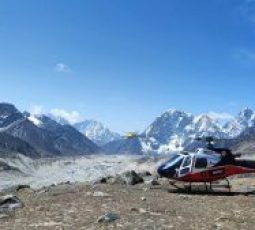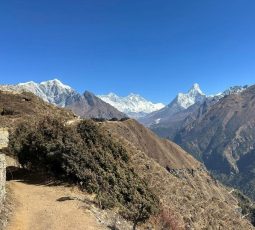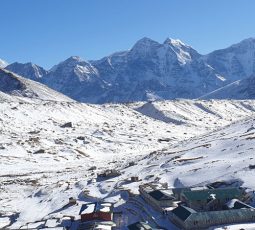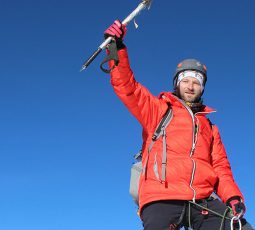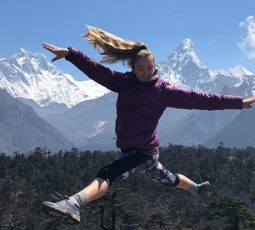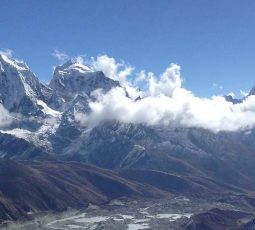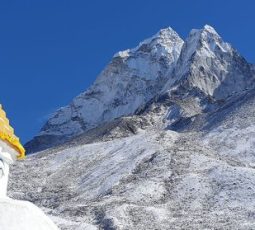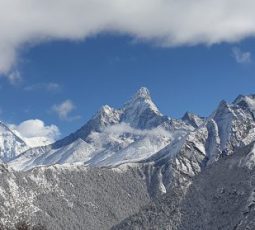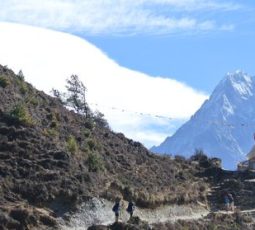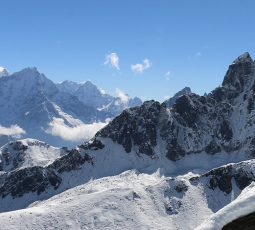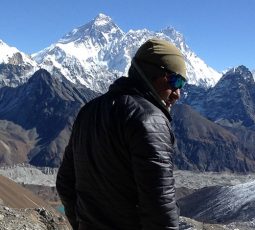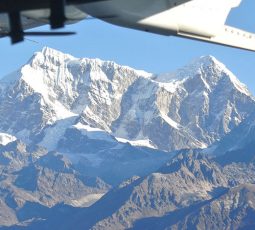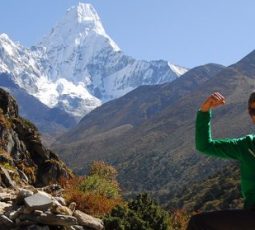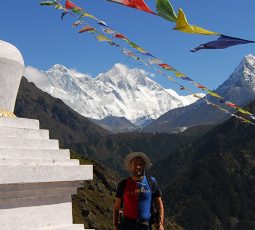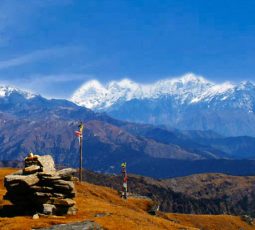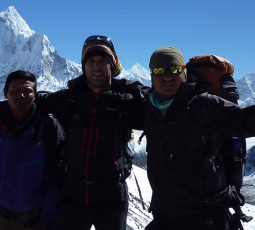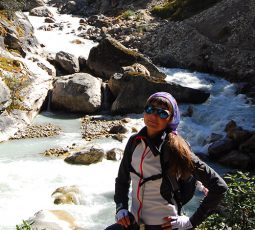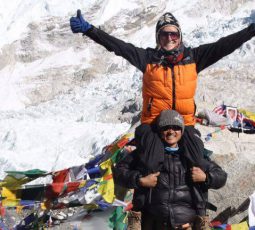Trip Facts
You may also like
Trip Highlights
- A picturesque flight to Lukla.
- Magnificent vistas of the range of mountains, including Mt. Everest, Mt. Lhotse, Mt. Ama Dablam, Mt. Nuptse, Mt. Thamserku, and numerous others.
- An investigation of the historic Tengboche Monastery and other Buddhist monasteries.
- Himalayan Monal and musk deer are examples of Highland wildlife.
- Trekkers travel through Namche Bazaar, a thriving center of Sherpa culture and trade.
- A UNESCO World Heritage Site known for its distinctive biodiversity, the walk passes through the Sagarmatha National Park.
- You will always treasure the once-in-a-lifetime experience of seeing sunrise and sunset against the backdrop of Everest and the surrounding peaks.
Popular trekking trails in the Everest region include the Everest View Trek. The world's highest mountain, Mount Everest, is referred to locally as "Chomulungma." A few days might be dedicated to the intermediate Everest View hike. People with a tight schedule will also find this walk to be quite suitable.
A quick yet stunning trip to the Everest region, the Everest View Trek allows you to see the world's highest mountain, Mount Everest, up close without having to hike too far or risk getting altitude sickness. All age groups can participate in this expedition.
Once you land at Tribhuvan International Airport and start exploring Kathmandu's UNESCO World Heritage sites, the Everest vista trek officially begins. Then, after finishing the prerequisite trek preparations, enjoy a breathtaking flight to the Lukla airfield.
Trekking to the Everest View offers stunning scenery and breathtaking views of the Himalayan giants, such as Mount Everest, Mt. Lhotse, Mt. Cho-Oyu, and Mt. Ama Dablam. diverse wildlife and plant life, stunning views of the whole Khumbu range, historic monasteries, and the distinctive Sherpa culture
You will explore airstrips in Syangboche as part of the Everest View trekking, where you may take in breathtaking views of Ama Dablam and Mount Everest. After that, you'll head towards Tengboche. Once more, you may enjoy breathtaking views of Mt. Everest and other high peaks from Tengboche.
Everest View Point
Seeing the Everest is one of the best things to do in Nepal. There are lots of viewpoints on the Everest view trek. When you land on Lukla airport you are already able to see some of the peaks around you. While you reach the Thadakoshi you Will see Kusum Kangaroos Base on your right-hand side. On the second day, you will be able to see the view of Thamserku Mountain on reaching the Benker and around. The first view of Everest is only possible from Day 2 while climbing from Hillary Suspension Bridge to Namche. The Everest view is only possible to see if the weather is clear upon reaching the first Everest viewpoint. While we reach Namche we can see Khongde and Thamserku from the hotel.
To See the view we need to go to the Everest View Hotel which has the clearest view of Everest along with lots of mountains such as Amadablam, Tobuche, Lhotse, Lhotse Shar, Nuptse Ridge, etc. While climbing to the Everest View Hotel, we will pass many small viewpoints that provide a view of Thame Peak, we will also pass the Syangboche Airport and Syangboche View Point which has a good view of Everest. During the Everest View hotel visit, we will also encounter many travellers who are doing an Everest base camp helicopter tour from Kathmandu. we can also see many monasteries on Everest view trek trails.
Outline Itinerary
- Day 01: Arrival in Kathmandu
- Day 02: Fly from Kathmandu to Lukla and Trek to Phakding
- Day 03: Trek from Phakding to Namche Bazaar
- Day 04: Trek from Namche to Khumjung
- Day 05: Trek Back to Namche
- Day 06: Trek from Namche to Phakding
- Day 07: Trek from Phakding to Lukla
- Day 08: Fly Back to Kathmandu
- Day 09: Spare Day
- Day 10: Final Departure
Itinerary
Getting to Kathmandu.
- welcome dinner 3 star hotel in ktm
The Everest View Trek officially begins with your landing in Kathmandu. You need to travel to your lodging. When you arrive at the hotel and check in, you can spend your free time lounging in your comfortable accommodation or exploring the popular Thamel neighborhood until dusk.
You can buy travel essentials and mementos while meandering around Thamel's narrow streets. There are enormous pagodas, vibrant temples, bustling streets, and vibrant marketplaces everywhere
Trek to Phakding after taking a plane to Lukla from Kathmandu.
35 minutes flight and 3 hours walk Breakfast, Lunch and Dinner Accomodation with Attached Bathroom
The Everest region may be accessed through Lukla. Manthali Airport may be the new destination for flights from Kathmandu to Lukla during the peak trekking months of March, April, May, September, October, and November.
Early in the morning, you will enjoy breakfast at the hotel before heading to the airport. If the weather is right, you will have amazing views of the Eastern Himalayas while on the excursion. The amazing aerial view of the mountains will enthrall you.
The journey starts when you land at Tenzing Hillary Airport in Lukla. You will first traverse a suspension bridge and hike 200 meters downhill to the Thado Koshi River of course. Mt. Kusum Kanguru appears to be spectacular from the bridge. Before you get to Phakding, you will shortly pass the tiny Buddhist settlement of Ghat.
Trekking from Phakding to Namche Bazaar
6-7 hours walk All Breakfast, Lunch and dinner from Menu attached room
After eating a quick breakfast, you begin your trekking excursion today by traversing multiple suspension bridges as you walk along the banks of the Dudh Koshi River. Snow-capped Thamserku Mountain gradually comes into view.
It's a stunning vista of the Khumbi-la Mountains and Thermasharhu Peak. Sagarmatha National Park's main entrance is close to Monjo. The majestic Himalayas (Kwangde and Kusum Kanguru) may be visible, as well as Everest and Lhotse, provided fortune favours you and the weather is clear
From Namche to Everest view hotel and down trek towards Khumjung
6 hours All breakfast, lunch and dinner from the menu tea houses and lodges
You move in the direction of Khumjung, leaving Namche Bazar behind. First you head uphill to a small airport at Syanboche, stopping at the well-known Everest View Hotel, a luxurious establishment with breathtaking views of the Himalayas around Mount Everest.
The climb out of Namche is steep. Furthermore accessible to visitors are the Khunde hospital, the Hilary school, the Yak breeding facility, the Khumjung and Khunde monasteries, etc.
This is how your journey comes to a close, and you eventually spend the night at a tea house in Khumjung that serves food. Additionally, you can observe that the school, which Edmund Hillary founded, escaped major damage from the Khumjung earthquake
Trek Back to Namche
3 hours walk Breakfast, Lunch and dinner Hotel with attached Bathroom
The sound of the raging Dudh Koshi River follows you today as you descend, adding a soothing tune to your journey. As you pass the challenging river crossings on strong suspension bridges, you'll get an adrenaline rush.
Gradually descending the Everest view hiking routes, you take in varied and stunning vistas that provide you with an understanding of the Sherpa way of life.
Entering Namche Bazaar, a vibrant Sherpa settlement, makes one feel more eager with each step. Upon your arrival, you will be welcomed with the gracious hospitality of the inhabitants and captivated by the vibrant markets.
Trek from Namche to Phakding
4 hours Breakfast. Lunch and dinner attached bathroom on lodges
It's downhill along the Namche to Phakding trail, moving from the higher elevation of Namche to the lower elevation of Phakding. In certain places, the fall can be fairly steep, so pay attention to your footing. You also leave Sagarmatha National Park, bidding farewell to Monjo.
The Dudh Koshi River, which rises in the Everest region, is crossed by a number of suspension bridges along the trail. Walking across these bridges and taking in the views of the flowing river below gives the walk an extra daring feel.
Trekkers frequently use Phakding as a resting place. It provides a selection of lodges and teahouses where you can spend the night and replenish with a hot dinner. It usually takes 4 to 6 hours to trek from Namche Bazaar to Phakding, depending on your pace and the number of stops you take along the way.
You can enjoy the travel because it's a doable distance.
Trek from Phakding to Lukla
3 hours Breakfast, Lunch and dinner good room with shower and toilet.
You will be returning to Lukla, the starting point, on this final day of your trek. While navigating through dense woodlands and suspension bridges, the Dudh Koshi River thunders past.
There will be plenty of time to revisit the fantastic memories you made along the way and reach Lukla at last. You will be rewarded with breathtaking vistas of Thamserku, Kusum Kanguru, and other nearby mountains along the trek.
On bright days, you might even be able to make out distant views of Lhotse and Everest. You'll catch your first view of the vibrant alpine town tucked away among the hills as you draw closer to Lukla.
Fly Back to Kathmandu
30 minutes flight Breakfast Included 3 star hotel in Thamel
You get up early, eat breakfast, and then take a domestic aircraft from Lukla to Kathmandu. As the small plane lifts flight, you'll be treated to an incredible overhead view of the wild terrain you traveled through.
Beautiful vistas of the Himalayas, including Mount Everest and other high peaks, may be seen on the trip from Lukla to Kathmandu. You will get the chance to see the grandeur of the tallest mountains in the world from the air on clear days.
After landing at the airport in Kathmandu, you just drive to your hotel, where you can spend the night or go shopping. You unwind for a while and think back on the amazing experience you've just had
Spare day (Encase of flight cancellation due to weather).
- depends where we are Depends where we are
There isn't an official program for you today. Therefore, you have two options: either stay at your hotel or go shopping. In the evening, you can partake in a traditional Nepalese supper and dances.
You can see Boudhanath Stupa, Pashupatinath Temple, Swayambhunath (Monkey Temple), and Durbar Square. Since Nepal's rich history and culture are showcased by multiple UNESCO World Heritage Sites in Kathmandu, each one offers a different perspective.
Soaring above the town of Boudha, in the eastern suburbs of Kathmandu, is one of the largest stupas in the world, known as Boudhanath. It is the holiest Tibetan Buddhist shrine outside of Tibet.
Enjoy the many tastes of Nepali food during your free time. Try some local favourites like momo's (dumplings), dal bhat (rice and lentils), curries, and other traditional meals by stopping by a restaurant or food cart.
Final Departure
- Breakfast -
Checking out of your Kathmandu lodging is how you start your leaving day today. The memories you create will last a lifetime, even though your voyage comes to an end today. Make arrangements for transportation to Tribhuvan International Airport based on your trip schedule.
Think back on the experiences you created during your Everest View Trek as you send a fond farewell to the stunning nation of Nepal. In order to remember your vacation, think about buying some last-minute gifts or souvenirs from the airport stores.
With so much time on your hands, you can plan your next trip and enjoy some of Nepal's most stunning mountain vistas along the route home.
What's included?
Everest conservation permits.
Everest view trekking map.
Full board plan (breakfast lunch, dinner) provided during trekking.
Hotel on bed and breakfast plan during Kathmandu stay.
An experienced license holder guide and required porters. (1 porter for two trekkers and there will be 1 assistant guide for more than six trekkers.)
International and domestic pick up/drop.
Medical kit box and required medicine for the trek.
Rounds tickets to Kathmandu-lukla for trekkers, guides, and assistant guides.
Trekking equipment like a down jacket and duffel bag will be provided.
TIMS Card (Trekkers information’s management system).
All necessary transportation during sightseeing.
Food, drinks, salary, equipment, insurance, transportation, accommodations, and local tax for guides and porters.
All government tax and VAT.
Welcome and farewell dinner with us.
if we need the reserve day at Trek then breakfast, lunch, and dinner with accommodations provided and in Kathmandu hotel on BB plan.
What's not included?
Your travel insurance.
Your international flights and departure tax.
Any expenses of a personal nature.
Tips for guide and porters.
Nepal entry visa fee.
Any kind of bar bills (alcoholic and nonalcoholic drinks.)
Rescue operation in case of emergency.
Departure dates
Private trips are available on any date of your choice at any time of the year. Let us know about your preferred travel dates and we shall organize it as per your convenience. Get in touch with us via bellow contact us form.
Essential Information
Best Time for Everest View Trek
When making the decision to embark on the Everest View Trek, the weather is the most important consideration. While there are seasonal ups and downs, adventurers, residents, and trek enthusiasts travel to Everest Base Camp year-round.
Spring and autumn are the ideal seasons for trekking because there are fewer clouds, less possibility of rain, and a bright sky. Let's examine the ideal travel seasons, weighing the advantages and disadvantages of each. If you choose the correct and best time to visit Nepal then the trip can be enjoyed in the full possible way.
Spring (March to May):
The weather makes it one of the ideal seasons for the Everest View Trek. Admire breathtaking vistas of the glaciers and Himalayan mountain ranges. March marks the start of spring and a warming trend in the weather.
Winter's massive snowfalls and summer's monsoonal rains are absent from this season. Highlights of the walk include the lovely weather, brilliant rhododendrons, and alluring vistas of the starry sky.
In mid-March, temperatures begin to rise, and snow mountains appear at their most picturesque under bright skies. Stunning photo chances will present themselves at every step because of the outstanding visibility of famous summits like Ama Dablam, Lhotse, Nuptse, and Everest.
The Everest region sees fewer tourists in the spring than during the peak trekking seasons of fall and October, even though spring is a popular time to trek.
Summer/Monsoon (June to August):
There are difficulties when trekking in the Everest region from June to August, which is the summer or monsoon season. Known also as the year's rainy season. Travelers are discouraged from hiking during this season because of the mud, leeches, sickness, and avalanche hazards caused by the rain.
Trekkers travel to Everest during these months, however, flights to Lukla may be canceled at the start or finish of the journey due to excessive rainfall. Although difficult, the walk is manageable.
Trekking in these months will reward you with breathtaking views of the waterfalls on relatively empty trails. The temperature is roughly 10°C at night and 27°C during the day.
The Everest region is blessed with an abundance of vegetation throughout the monsoon season, despite the problems presented by the rain: forests, valleys, and hillsides teeming with life. The surroundings are changed to a lush paradise.
The reduced view of the mountains is one of the primary disadvantages of trekking during the monsoon season. For those trekkers who come for the amazing landscape, cloud cover frequently blocks views of the famous peaks, which can be discouraging.
Winter (December to February):
In particular, from early January to early February, is when it gets the coldest. It's very cold because of the considerable snowfall in the trek areas. The overnight is bitterly chilly, even though the daytime is clear and pleasant with warm temps.
Even though it's typically dry, the days can get quite cold—nighttime lows can reach -20 C. Though it would seem impossible at this time of year, it is still possible to accomplish the Everest Base Camp Trek.
In the Everest region, snow and ice may be encountered on the paths during winter trekking, particularly at higher altitudes. Some of the most stunning and unobstructed views of the Himalayan peaks may be found in the winter.
The snow-capped mountains against the brilliant blue sky are easily visible due to the frequently crystal-clear skies. When trekker traffic declines in the winter, some tea shops and lodges along the Everest View Trek route stay open, but others may close or operate on a condensed schedule.
Fall / Autumn (September to November):
Moreover, these are some of the best months for trekking to Everest View. It is during these months that a large number of trekkers travel to Everest. Perfect trekking weather arrives as the monsoon gradually ends. The daytime high is twenty degrees, and the nighttime low is five.
September through November is known as autumn, and it's also marked by sunny skies, pleasant temperatures, and a decreased chance of bad weather or precipitation. Because of the frequently clear skies, trekkers may take in expansive views of the snow-capped mountains set against a brilliant blue sky.
For those who enjoy taking pictures, the scenery is just breathtaking. Furthermore, as autumn is one of the best seasons, you will meet a lot of other travelers from all over the world.
Trekkers can enjoy cozy lodging and substantial meals at the majority of tea houses and lodges along the Everest View Trek route, which are open and fully functional during the autumn season.
Everest View Trek Difficulty
For those who are new to trekking, this is an easy trek. But there are some difficult climbs in rough terrain to be had. Furthermore, some may find the high altitude difficult. For those in reasonable health, most travelers can complete the Everest View Trek schedule without much difficulty; prior trekking experience is not required.
On the other hand, altitude sickness symptoms are probable at this trek's highest point, which is about 3,700 meters. It follows that before starting the Everest View Trek, you should be in excellent health and physical condition.
As you ascend higher into thinner air, altitude sickness frequently occurs. This trek requires careful acclimatization and the taking of all required measures. Yet since you will be trekking to a height of about 3,500 meters on our Everest View trek, the likelihood of experiencing altitude sickness is reduced.
A good method to get ready to visit the high-altitude Khumbu region is to engage in cardiovascular exercise such as walking and running. Maintaining physical fitness will enable you to go to your destination hassle-free and to fully enjoy the experience. It can also lessen the possibility of accidents for hikers.
Though they might not be as comfortable as hotels or lodges in cities, lodgings do offer necessities like meals, blankets, and beds. Many types of weather can be encountered by trekkers, especially in the winter and monsoon seasons. These include sunny, warm days, chilly nights, and sporadic snowfall or rain.
Despite being rated as a moderately challenging walk, the Everest View walk nonetheless demands careful planning, physical health, and an adventurous attitude in order to truly appreciate the experience of hiking.
Communication on Everest View Trek
The Everest region offers amazing scenery and difficult terrain for hikers to encounter. A safe and enjoyable journey depends on effective communication. Local Nepalese network operators provide mobile phone connectivity in certain areas along the Everest View trip. However, the coverage might only be available in specific areas of the path and be sporadic.
The two biggest mobile network providers in Nepal are Ncell and Nepal Telecom (NTC). These suppliers provide the Everest Region's broadest coverage. Voice calls, SMS, and data are among their services.
Wi-Fi is available for a charge at a few tea houses and lodges along the trekking route. Please be aware, however, that the internet connection can be spotty, sluggish, or limited to public spaces. Remember that as you get higher in altitude, Wi-Fi may become less accessible.
For emergency communication, certain tea houses and hiking guides may have satellite phones in more isolated locations without internet access or cell phone coverage. But renting or buying them can be costly, and for the best reception, they might need a direct line of sight to the sky.
Offline communication techniques are in handy when there's no dependable internet or cell phone connectivity. Having a tangible map, guidebook, or trekking itinerary that contains crucial details about your schedule and lodging is one way to do this.
Using roaming services on a foreign SIM card can be highly costly for those who travel extensively. Generally speaking, using a local SIM card is more economical. When there is adequate connectivity, which is usually in lower locations, trekkers are recommended to share their plans and updates.
Remember that there aren't as many communication options along the Everest view treks as there are in cities. But the Everest view trek has better communication than the Magic Himalaya Everest Trek.It is recommended to set up a schedule for frequent check-ins and let your loved ones know about any potential communication limits.
Food During Everest View Trek
Trekkers need to eat a well-balanced diet in order to sustain their bodies and fulfill the physical demands of the challenging terrain and breathtaking Himalayan scenery. Because this trip takes you to high heights on the edge of the tallest peaks in the world, you'll need to bring along extra nutrition like proteins and carbs.
A menu found in most tea houses is quite standard. The tea house menus are divided into sections for breakfast, lunch, and dinner, with three options available each day. If you want to give your body the energy it needs for the day, eat a full breakfast before going for a walk.
Dal Bhat, a staple meal of Nepal, is usually served in the tea houses along the Everest View Trek route. There are other tea houses that provide traditional Nepali food. This is a traditional Nepalese dinner of lentil soup (dal) with steamed rice (Bhat). With a great balance of minerals, protein, and carbohydrates, this wholesome lunch is ideal for hikers. It's filling and substantial.
Thukpa is a type of noodle soup that sometimes includes meat and mixed vegetables. Mountaineers seeking food and warmth adore Thukpa. EBC tea shops often serve macaroni and pasta lunches to cater to the likes of foreign trekkers. These are simple and filling options for those who like popular Western dishes.
Packing lunches to take on the route is something that some tea shops offer to hikers. They usually consist of things like water or juice, biscuits, fruits, boiled eggs, sandwiches, and biscuits.
The Everest region is known for its oil-cooked flatbread, which is flavourful, filling, and occasionally rather oily. Bread also contains a lot of carbohydrates, which are necessary to maintain energy levels during strenuous hikes.
Every food in the Everest region will never be exceptionally fresh due to the area's isolation and limited accessibility. The fact that the food is not as fresh as hikers would have preferred is one common complaint. One way to be certain you are getting fresh food is to stay at tea shops that are busy or look busy and full.
Accommodation on Everest View Trek
The 10-day Everest Panorama view Trek involves nine nights spent traveling between lodges in the trekking zones. Another crucial component of the journey is lodging. You will be able to stay in the local communities throughout the lovely trekking adventure. These are straightforward lodgings with minimal amenities.
Tea houses, sometimes referred to as trekking lodges or guesthouses, are the primary type of lodging available on the Everest View Trek. Along prominent trekking routes in Nepal, such as the Everest View Trek, tea houses serve as budget hotels or guesthouses for hikers and travelers.
Not all of the rooms have attached bathrooms, but most offer two or three single beds with warm blankets, cushions, and soft mattresses. Some rooms also have great views. For solitary female travellers, however, a separate room will be available during the walk at no additional cost.
A hot shower is the nicest feature of some tea houses at lower altitudes. Other amenities include power, wifi, and fully equipped rooms with a Western-style toilet. By contrast, a number of tea rooms—especially those at higher altitudes—offer very basic amenities.
Some tea houses on less-traveled treks simply offer buckets of hot water, but all tea houses at Everest View Trek have electric or solar heaters. The tea house is a great place to meet folks looking for adventure trips in this area.
Guesthouses are like tea houses in that they provide simple lodging with common amenities. A comfortable and genuine mountain experience is offered by these family-run establishments in the area.
Note that certain settlements may have limited lodging alternatives, particularly in the spring (March to May) and autumn (September to November) trekking seasons. It is advised to make hotel reservations in advance.
Drinking Water on Everest View Trek
Setting out on a trek in the Everest region is an unforgettable experience, but it presents a special set of difficulties, especially when it comes to staying hydrated. For a nominal charge, the majority of tea houses and lodges along the Everest View Trek provide boiled water. Boiling removes germs and other pathogens from water, making it one of the safest methods for preparing drinking water.
- A safe trekking trip requires an understanding of the utilization of the numerous natural water sources scattered throughout the area, which is renowned for its untainted and austere beauty.
- Little rivers and streams that are fed by melting and glaciers frequently cross the pathways. These sources could seem clean, yet they could be tainted with microbes.
- In the upper altitudes of the walk, glacial melting water is another frequent source of water. Despite coming from glaciers, it can still get contaminated.
- Mountain springs are scattered across the walking paths. Although they need still be treated, springs are typically safer than surface water sources.
On the market, there are many different kinds of purification pills that are intended to make water safe to drink. A "neutralizing" tablet might also be necessary because some have an unpleasant taste. The water is chemically purified by these tablets or drops, making it safe to drink.
Certain bottles come with built-in filters; to use one, simply fill it up, replace the cap, and sip. Portable water filtration technologies like gravity or pump filters can be employed to purify water from natural sources.
Everest View Trek Booking Policy
You must pay a deposit in order for us to set up your flexible dates when making a reservation for a trek. An advance payment of precisely 20% of the entire amount is required.
Some businesses request payment of up to 50%, which is improper. Your payment is refundable, and the terms will be reviewed. You may read more about the cancellation policy below. Upon arrival, the remaining 80% of the total must be paid.
You can also choose to pay in full upfront with Magic Himalaya, and doing so is secure. Several payment methods, including credit cards, Master cards, Visa, and direct bank transfers, are accepted by our company.
The bank charges fees for making payments in accordance with a government of Nepal policy. Traveller's checks are not accepted here; however, cash is accepted.
You might not like the Everest view trek Booking Policy but you will find it the most safest way of booking once you trek with us.
Electricity on Everest View Trek
Though it's vital to have reasonable expectations regarding its availability and reliability, electricity access for hiking in the Everest region has improved dramatically over the years. Depending on your exact location and the infrastructure of the communities you pass through, the Everest View Trek's electricity availability may vary.
Electricity Sources:
- Solar power is a common source of electricity for the Everest region's tea houses and lodges. For lighting, charging stations, and other necessities, solar panels are used by a large number of tea houses and lodges along the Everest View Trek to produce electricity.
- Some settlements get their electricity from tiny hydroelectric power plants. In lower altitude regions, this is more typical. Usually, these stations are made up of turbines that use the water's flow as power, turning kinetic energy into electrical energy.
Electricity is generally available and reasonably dependable in lower altitude areas such as Namche Bazaar, Phakding, and Lukla. Particularly at higher elevations, charging electrical devices frequently requires an additional charge due to limited power resources.
There may only be lights available during certain evening hours in some isolated or higher-altitude tea houses. Planning ahead, having the tools you need for charging and being ready for sporadic power outages are crucial, particularly when you're in a remote or high-altitude location.
Permits Required for Everest View Trek
Each year, thousands of trekkers, naturalists, and adventurers come to this region to admire the breathtaking scenery. As a result, authorization to enter the Everest region is needed for every travel. For the Everest View Trek, two permissions are normally required:
Trekking in the Everest region requires obtaining both the Sagarmatha National Park Permit and the Khumbu Pasang Lhamu Rural Municipality Permit. If these permissions are obtained, trekkers will be able to accomplish their goals without running into any legal problems or inquiries.
There are various places where you can get these permits. Different sources do not suggest that you can purchase them arbitrarily from any vendor; you must have permission. Permission of Entry into Khumbu Pasang Lhamu Rural Municipality A major expense associated with an Everest View Permit is the Khumbu Pasang Lhamu Rural Municipality Entrance Permit.
You will need this permission as one of the first things before you can start your Everest View Trek.
- Foreign nationals must pay $30 (VAT included) per person for a single entrance.
- Citizens of SAARC countries: Rs. 1500 for a single admission (including VAT).
- For Nepali a single entry (VAT included), costs Rs. 100 per person.
- For those under 10, it is free.
Once you reach Lukla, the Sagarmatha National Park Entry Permit will come in handy when visiting Phakding and other locations. Under the direction of the Nepalese government, the national park committee itself grants SNP permissions.
At the Monjo entry gate or at the Department of National Park and Wildlife Conservation (DNPWC) counter in Bhrikuti Mandap, Kathmandu, you can obtain admission permits for Sagarmatha National Park.
- Visitors from abroad are required to pay NPR 3,000 per person, VAT included.
- Including 13% VAT, the entrance fee for SAARC nationalities is NPR 1,500 per person.
- NPR 100 for each person and entry in Nepalese.
- Children under 10 enter free of charge.
You need to show your passport in order to receive this authorization. You may need to present the permits at checkpoints, so have them with you at all times as you stroll. It is important to keep in mind that only authorized trekking firms are able to provide permits.
Note: Now, there is the introduction of trek cards in the Everest region.
Fauna Seen During Everest View Trek
The Everest view trek provides a rare opportunity to interact with the varied species of the Himalayas, in addition to its magnificent peaks and stunning scenery. Discover nature's hidden treasures and enter untainted areas where the magical and the wild collide.
However, there are a few uncommon but striking animals that live in the trekking area at lower altitudes. It is home to creatures such as the stately Snow Leopard, which is both intriguing and imposing.
As altitude increases, the temperature and oxygen content drop. Because of this, the species that inhabit this area have evolved to survive in low-oxygen environments and in the winter. Their thick coats help them to keep their body heat.
Snow Leopard
With just 6,000 of these enormous cats left in the wild, they are highly rare and endangered. Due to their extreme cold and high altitude, snow leopards have developed unique adaptations.
Himalayan Thar
Large and goat-like, the Himalayan thar has a dark brown coat, black facial markings, and a characteristic white beard. The Himalayan tahrs have to be reintroduced into some areas of their habitat since they are deemed "near threatened" in the wild.
Yak
One of the most amazing cattle in the world, the yak is suited to live on "the roof of the world," where conditions are so severe that not many other domestic animals can make it.
Red panda
Lesser pandas, often called red cat-bears or red pandas, are uncommon animals to see. At lower elevations, Sagarmatha National Park's bamboo thickets are home to these raccoon-like creatures.
Golden eagle
It is a huge predatory bird that may be found at high altitudes and is distinguished by its enormous wingspan.
Apart from these species, the Everest region is home to a wide variety of other animals including pheasants, different kinds of snakes and reptiles, and Himalayan black bears and Gorals. For these animals, many of which are unique to the globe and suited to live at high altitudes, the area serves as a vital home.
Simple Equipment List
It is essential to be well-prepared before embarking on any trekking trail in the Everest region. The right gear will make your trip enjoyable from beginning to end. If you are traveling to Nepal without any equipment, keep in mind that you may rent or purchase it in Kathmandu for a very affordable price. Here is the simple equipment list for Everest view trek:
Footwear:
- Trekking boots
- Sports sandals
- Accessories:
- A sleeping bag with a zero DC rating.
- Duffel bags and trekking bags.
- Headlamp with extra batteries and bulbs.
Big plastic bags - to keep stuff dry inside the trekking bag
Poles for trekking
Two water bottles
Toiletries
Cap or sun hat
polarised sunglasses
woolen hat
Individual first aid pack
Copies of Passports
Luminous
Binoculars
Map of the trail and guidebook.
Visa Information To Be Noted
Once you arrive at Kathmandu's Tribhuwan International Airport, issuing the visa will be simple. Two passport-sized pictures and $30 USD per person are needed. To obtain a tourist visa, you must:
- A passport that is still valid (at least for six months).
- For visas obtained at airports or immigration entry points, you need to complete the application form.
- You must pay the visa fee in cash.
- 2 passport-sized photo.
Visa Charges:
- USD 30 or fifteen days' worth of equal convertible currency.
- USD 50 or 30 days in a comparable convertible currency.
- USD 125 or ninety days' worth of equal convertible money.
- Free visa for tourists from SAARC countries for a maximum of 30 days.
Flora Seen During Everest View Trek
The highest peak on Earth is not the only reason that the attractive Everest Region is well-known. It is also appreciated for being distinctive among the many interesting plant species.
Depending on height, the vegetation in the Everest region changes. The bottom area is primarily covered in subtropical woods with oak, pine, juniper, and rhododendron trees. Alpine meadows with high-altitude mushrooms, herbs, and little floral plants await you on your trekking route as the altitude rises.
The vegetation and plants in the area vary depending on the time of year we come because different seasons bring out different flowering seasons. Nestled in the core of the Himalayas, the Everest Region serves as a haven for several of the planet's most imperiled species, as well as a tribute to the magnificence of the earth.
Among the frequent plant species observed are:
- Rhododendron.
- Himalayan birch
- Edelweiss
- Juniper
The national flower of Nepal, the rhododendron, grows in profusion in lower-altitude forests. Mid-altitude forests are home to juniper trees, which are prized for their aromatic wood. High-altitude areas are home to Himalayan birches. Grown in alpine meadows, edelweiss is a tiny blooming plant distinguished by its fuzzy, white blooms.
Numerous uncommon plant species are growing in this area. One such bloom that has come to represent the upper Himalayas is the Himalayan blue poppy, which is incredibly lovely. These forests are essential to preserving the region's biological equilibrium in addition to providing a pop of color to the surroundings.
Due to its effects on ecosystems, changes in species distribution, and effects on flowering and breeding cycles, climate change poses a serious danger to the biodiversity of the Everest Region. For the ecosystems in the area to remain healthy and stable, the park's flora must be preserved
Toilet Facilities on Everest View Trek
The availability and amenities of restrooms are something that hikers should be aware of before visiting any mountainous area. It's possible that you've seen images posted on social media or heard rumors from others regarding the restrooms.
You can find sit-down toilets that are just like the ones you're used to back home in the more crowded and lower altitude regions such as Lukla and Namche Bazaar. They are practical but simple restrooms, so don't expect a five-star experience.
The restrooms in most guesthouses are squat. Upon above 3,000 meters in elevation, sit-down restrooms become an uncommon amenity. Because your skin isn't in contact with the toilet seat, many people think they're more hygienic. For those who have never used these flat toilets or have never gone to a rural region, using squat toilets may be uncomfortable.
To ensure that your time in the restroom is as comfortable as possible, you should bring the following items:
- Toilet Paper: Toilet paper isn't a given in many hotels and tea houses along the trek, which may surprise you. Thus, having your own paper roll is a good idea.
- Hand sanitiser: Another item you'll frequently find missing from the restrooms is soap. To help you stay germ-free, a little bottle of hand sanitizer can be quite helpful.
- Wet wipes: When soap and water are not easily accessible, they offer a rapid and effective method of hand cleaning.
The restrooms may have icy surfaces if you are on an Everest View Trek between November and the beginning of March. When you enter the bathroom, take caution as the ice makes the floor slick.
Required Nutrition and Hydration for Everest view trek
When trekking to Everest View, maintaining and preventing altitude sickness depends heavily on nutrition and hydration. Ensuring that sufficient nourishment and hydration are essential components of a successful and healthy hiking experience.
Sufficient oxygen is carried throughout the body thanks to improved blood circulation brought on by enough hydration. At high elevations, the body needs more energy to function. Carbohydrate-rich diets can supply this essential energy. Maintaining your strength throughout the trek is made possible by a balanced diet, which helps muscles utilized in trekking heal and regenerate.
Acute Mountain Sickness
With its unmatched views and once-in-a-lifetime experience, trekking the Everest region is an amazing adventure. It is vital to comprehend the potential hazards linked to trekking at high altitudes, namely Altitude Sickness.
A prevalent concern for hikers heading up to the high altitudes of the Himalayas is this ailment, which frequently presents as Acute Mountain Sickness (AMS). The adverse reaction of the body to being forced to rise to a high altitude too soon is known as altitude sickness.
At any altitude of around 3,000 meters (9,840 feet) above sea level, altitude sickness can occur. This is due to the fact that the air becomes thinner and has less oxygen as you climb higher in altitude.
For example, the number of oxygen molecules in each breath is around 40% lower than 3,600 m (12,000 ft). This explains why, at high altitudes, we breathe more deeply. This causes the body to gradually weaken. Reduced oxygen and air pressure can lead to acute mountain sickness (AMS).
Understanding Symptoms
Knowing how to spot the signs of altitude sickness is essential for anyone doing the Everest View Trek. Early detection of these symptoms can facilitate prompt intervention to stop the illness from getting worse.
Among the basic and initially manifesting signs are:
- Headache
- Feeling queasy and throwing up
- Lightheadedness and dizziness
- Weakness and Fatigue
- breathing quickly or having trouble breathing
- appetite decline
- Unpredictable sleep patterns
- sleeplessness vivid dreams
The person eventually loses their senses of touch, sight, and hearing if the aforementioned symptoms continue or get worse. If symptoms don't go away after a day or two, go to a lower elevation and get help right away.
Below is a list of some preventative measures for AMS:
- Ascend gradually.
- Avoid drinking alcohol and smoking.
- Another key to avoiding AMS is to stay hydrated. Throughout your ascent, sip water frequently.
- Eating the right foods can help prevent altitude sickness during the trip.
- Identifying the symptoms is the best defense against AMS.
- Assess your red blood cell count prior to climbing to higher altitudes.
Travel Insurance requirements
For security purposes, you really need travel insurance. Engaging in any trek or tour program in the mountains is a need for trekkers. For those who are taking on a strenuous and sometimes dangerous trek, travel insurance for the Everest View Trek offers coverage for unforeseen circumstances or accidents that may arise during the journey.
An adventure as demanding and exciting as trekking to the world's highest peak region will leave you with lasting memories. In order to protect against unanticipated events, it is imperative to obtain travel insurance coverage.
Things including illness, medical emergency, accidents, death, trip cancellation, and loss of personal belongings and baggage must all be covered by the travel insurance. In Nepal, all expenses related to emergency evacuation must be paid in cash, unless your insurance provider has consented to cover the full amount.
Trekkers in the Himalayan region frequently suffer from altitude sickness. Medical care can be costly in the Himalayan region, particularly when emergency medical evacuations are involved. It is crucial to have medical emergency-covering travel insurance for the trek for this reason.
Thus, in the event of an emergency or disaster, helicopter rescue may be required, and travel insurance can pay for the costs. However, if you don't have travel insurance, it gets expensive.
For your protection and security throughout the Everest View climb, selecting a legitimate travel insurance package is essential. Investigate and contrast various insurance companies to identify the finest plan that satisfies your needs in order to select a dependable and trustworthy insurance provider for Everest Base Camp.
Everest view Trek cancellation Policy
There may be times in your life when there is nothing else you can do but cancel the tour you have scheduled. This could be an unexpected emergency or a variety of challenging, unforeseen circumstances. There are no alternative options under certain circumstances than cancelling your trek. If you have booked Everest view trek and in case something makes you to cancel the trek. At that point you will find it difficult with the amount you have paid as and advance. There will be various items and cancellation policies that you must be aware of when cancelling. Magic Himalaya treks have a normal policy which suits you if you have to cancel the trek. The following points help to clarify and lead us.
- You will receive 30% of your advance payment deposit back if you cancel the tour one day before the scheduled departure.
- You will not receive 10% of the deposit back if you cancel the tour three days prior to the scheduled departure date.
- You will not receive 10% of the money back if you cancel the tour one week before the scheduled departure date.
- You will receive 100% of the deposit back if the tour is cancelled due to bad weather or other reasons.
- You won't receive any money back if the customer decides to cancel the tour after it has begun.
- Should the company receive a cancellation request on the day of the tour, appropriate cancellation fees will be assessed.
- In the event that the company cancels, you will receive a full refund or a postponement of your choice. You have an option.
Note: It is best to postpone the tour or suggest it to your friends and family rather than cancelling once you have made your reservation.
FAQ
Answer: Indeed, in the event that the scheduled group departures conflict with your travel itinerary, you are free to select your own departure dates based on availability and timetable.
Answer: It is quite uncommon, however, some people may have insignificant headaches along with modest altitude sickness symptoms, which is not regarded as a significant risk factor. Even below 3000 meters, altitude sickness can still strike. Even at 5,000 meters, some hikers may never feel any pain, while others may become ill at elevations as low as 3,000 meters (9,842 feet).
Answer: The best times to undertake an Everest View trip are from March to May during the pre-monsoon season and from late September to December during the post-monsoon season. Although it is possible to do this walk between February and early September, the aforementioned months are the optimum times to undertake it.
Answer: To see Mount Everest, the easiest journey is the Everest View Trek. You will take a plane from Kathmandu to Lukla and then walk to the summit of Everest. Or trek to the Tengboche Monastery, return to Lukla, and take a plane to Kathmandu.
Answer: The law does not require travel insurance for the Everest View Trek, however, it is highly recommended to safeguard oneself against any unanticipated circumstances.
Answer: Be psychologically and physically prepared, drink lots of water and stay hydrated, eat a sufficient and balanced diet, and avoid alcohol, cigarettes, and tobacco during the entire trek, ascend slowly with appropriate rest and acclimatization. This way you can prevent it.
Answer: The hike is mostly moderate in difficulty, with a few challenging sections. The trail from Lukla to Namche Bazaar is quite steep and untidy, making it a difficult walk. It's not as hard as one might think to walk if you have a strong will, good mental health, and physical fitness.
Answer: Indeed. Travel insurance can offer financial protection in the event of emergencies or unforeseen circumstances, but having a companion and porter can assist avoid such scenarios altogether, so you will undoubtedly require guides and porters.
Answer: Sure, you can, of course! One of the easiest things that anyone 8 years old and older with a reasonable level of fitness can perform this trekking. People of all fitness levels can enjoy it because it's a significantly easier trip than the entire Everest Base Camp trip.
Answer: Medical costs, such as medical evacuation, trip cancellation or interruption, lost, stolen, or damaged luggage, and accidental death or disability, are usually covered by travel insurance for Everest View Camp.
Answer: The Khumbu subregion of Province No. 1 on Nepal's Everest View Trek will lead you to the village in the rural municipality of Khumbu Pasanglhamu.
Answer: Trekking up Everest is a traditional way to see the highest peak in the world while traversing mountains. Admire the breathtaking views of numerous mountains, including Kongde, Kusum Kanguru, Cholatse, Ama Dablam, Mt. Thamserku, and Mt. Everest.
Answer: During the trek, there is a bank, ATM, or money exchange available until Namche. We have ATMs and banks in both places in Lukla and Namchebazar. There is also money exchange in both Lukla and Namche but they give you low rates so it's better for you to bring additional Nepali rupees with you from Kathmandu.
Answer: This is a trek that anyone in good shape can complete, regardless of experience level. You need to be ready for long days and reasonably fit. You will enjoy your trekking adventure more if you are in better shape.
Answer: The Sagarmatha National Park Permit and the Khumbu Pasang Lhamu Rural Municipality Permit are needed for trekking in the Everest region. Trekkers will be able to complete their objectives without encountering any legal issues or questions if these permissions are secured.
Answer: Everest View Trek is the Top best trek in Nepal among the short and easy trek. This trek is suitable for all age groups of people who dream of walking and seeing Everest from their eyes.




